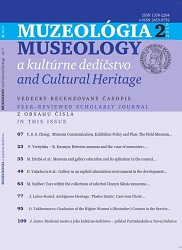Moderné mesto a jeho kultúrne dedičstvo – príklad Partizánskeho a Novej Dubnice
Modern City and Its Cultural Heritage – the example of Partizánske and Nová Dubnica
Author(s): Juraj JantoSubject(s): Cultural history, Architecture, Recent History (1900 till today), Social development, Rural and urban sociology, History of Art
Published by: Univerzita Komenského v Bratislave, Filozofická fakulta
Keywords: modern city; socialist realism; cultural heritage; Partizánske (Baťovany); Nová Dubnica;
Summary/Abstract: The paper deals with the issues of architecture and cities, or urban neighborhoods, which originated in the 20th century. While older style architecture and urban structures are already protected by law and generally accepted by both professionals and the public as part of cultural heritage, the situation is different for newer towns and buildings. However, these are also often unique collections, witnesses of the time and holders of other historical, technical or artistic values. This is particularly evident in the case of greenfield cities – Partizánske (1938) and Nová Dubnica (1957). Both locations grew up as an expression of contemporary ideas about an ideal city in connection with industrial factories, whose employees they were built for: Partizánske (former Baťovany) as an ideal industrial settlement of the Baťa concern and Nová Dubnica as a representative socialist city. The first one was based on the concept of modern architecture (and urbanism) and the second one was associated with socialist realism (as a critical, ideologically conditioned refusal of modernism).The original urbanistic concept and architecture of both settlements have remained largely preserved to this day, but their legislative protection is needed. Protection and maintenance are also, and above all, a matter of interest and acceptance of the wider public. After all, the relationship of the citizens is also reflected in the protection and overall care for the heritage. The first step in building this relationship is to make people aware of the importance of the values they contain.
Journal: Muzeológia a kultúrne dedičstvo
- Issue Year: 7/2019
- Issue No: 2
- Page Range: 109-121
- Page Count: 13
- Language: Slovak

